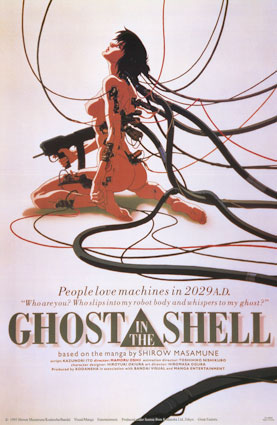A short summary of the series Ergo Proxy is a story about Vincent Law, an immigrant worker trying to find a stable life in Romdo city, a hi-tech yet isolated megacity enclosed in a dome. Upon his arrival, strange things such as unexplained killings and scary apparitions happen. These anomalies catch the attention of Real Mayer, a prominent citizen and police inspector of Romdo. At first, she is gung-ho about investigating the unusual events until she too is attacked.
This puts Vincent in the wanted list; however, with the help of Pino, a gynoid, he escapes Romdo and wanders the outside wastelands. Not long after, he manages to find himself a floating ship. Back in Romdo, Real learns about the truth that there is a world outside the city. Despite objections from her powerful grandfather and doctor, she sets out to find the answers she seeks.
The three characters meet and set out to Moscow city, Vincent’s birthplace in search of the truth. Along the way, bits and pieces of Vincent’s real identity are revealed. However, before the reach Moscow, the city is destroyed by a thermonuclear missile launched by a high ranking Romdo citizen. This forces them to go back where it all started, to Romdo.
Identity
Basically, the entire series is a continuous search for Vincent’s identity. He is a Proxy, a term used for super specimens (uebermensch) that preserve the post-apocalyptic world. However, he doesn’t know that he is one, the most powerful one. Along the way to Moscow city, Vincent encounters his own kind, the other Proxies. Through them, he comes to accept who he is. But this didn’t come easy for Vincent. He had to endure the trauma of the realizing that the life he led until that time was merely an illusion. Throughout the series, he battles his own denial.
Real, on the other hand is revealed to be some form of creation. In the later episodes of the series, her doctor creates a clone due to jealousy and calls it real. Real’s crisis only surfaces later in the series when they come back to Romdo.
I am amused with the psychological states of the characters, especially Real’s. During the lonely travel, where Real is the only human among the three of them, it is she who had the hardest time adjusting to the new environment considering that she was a prominent citizen of a wealthy city dome. However, when you watch the journey very carefully, you’ll notice that Real’s personality is half unreal. Her best friend and confidante is a robot, and I bet she hadn’t talked to a real human for a long time. Imagine yourself being a rich girl with no one but a machine to talk to, and then suddenly and with no prior knowledge, you venture into the unknown, parting with your old life. You realize that all you know is false, and because of it, you undertake a once-in-a-lifetime journey to learn the truth. Then when you come back home, you see that you’ve been replaced with an exact copy of yourself. That’s Real Mayer in a nutshell. Maybe that’s why she’s named “Real” in the first place.
Artificial Sentience
Ergo Proxy deals with my favorite topic, Artificial Sentience by way of the Auto Reiv. Pino is what the series calls as “Auto reivs”, humanoid machines built to serve (and sometimes replicate) man. However, like numerous auto-reivs like Iggy (Real’s robot confidante), she contracts this so-called “Cogito virus”. This virus, like Descartes’ declaration of existence, infuses the machines with some sort of a soul. When infected, they acquire distinctively human traits such as reason and the ability to feel emotions like happiness, jealousy and love. They also acquire free will and begin to act according to their own volition. Pino, for example would demonstrate this free will by writing with her left hand only, despite being ambidextrous. Iggy, on the other hand, demonstrated his by abducting Real in an “attempt” to “protect” her, instead of following her orders to turn back.
The humans in Ergo proxy view this negatively. In Romdo alone, special extermination squads are employed just to dispose of Cogito infected auto reivs. Of course, this is simply an issue of technological singularity. The machines are beginning to threaten the relevance of humans. Thus, they must be destroyed before they destroy us.
This issue is just as ethical as it is political. First, in the ethical sense, is it right to destroy these beings when they are already as human as they can be? Personality wise, they are just like us. They feel the same things we feel. They think like we do, except that they have metal bodies. The question I want to raise is, “Do they not have rights because they are metal?” , I mean, if we have human rights because we are human, and animals have animal rights because their animals, why not machine rights, especially if these machines are every bit as human as we are? Is it right to just destroy them, if it’s possible that they too, feel pain and suffer in the process?
The next is the political side of this issue. Auto reivs are what Negroes were during the 19th century in America. Negroes are human too, but they are black. Therefore, they are considered property and denied rights until Lincoln emancipated them. In a way, the infected Auto reivs are similar. The question here is “where do political rights come from?”. Is it the physical composition, where whites were distinguished from blacks by color alone and humans from auto reivs by flesh alone? Or what?
I believe that we cannot fully tackle this issue for good until we reach such a technological level.
Raison d’être
The three main characters tackle their own issue of Raison D’être. Vincent as a proxy, Real as a human, and Pino, as a cogito infected auto reiv.
First is Vincent. As the most powerful proxy, he comes to his senses very late. Vincent re-awakens at a time where proxies are no longer needed because humans are progressing again. Proxies act like a sort of god-patron of each domed city. It just happened that Vincent, in the form of Ergo Proxy is the patron of Romdo, and he has the power to destroy it whenever he wants. What is the use of beings like them when humans succeed in controlling their own fates? Much like what purpose deities serve when we ourselves determine the way of the world. The awakening of Ergo Proxy symbolizes a desperate attempt by “the past” to claim a “reason to be” before it is brushed aside by progress. If he doesn’t act now, he might as well not exist as he would no longer have a role to perform. In our context, it is like the “second coming” during a hypermodern age. AS SOON AS WE MANAGE TO CONTROL OUR FATES, GODS WILL BE RENDERED IRRELEVANT! THEY WILL LOSE THEIR REASON TO BE, AND THUS WITHER AWAY! In a sense, Ergo Proxy’s reawakening tells more about the people than the proxy. The struggle is basically something that symbolizes people moving forward on their own while a jealous God is trying to foil their liberation by asserting himself.
Second is Real, her reason to be after being assaulted was to know the truth. Her life became a single-minded obsession to know. After her realization that there is a world outside Romdo, knowing became her reason to be. If she had stayed within the dome, she might as well not exist. In some ways, Real Mayer is the representation of humanity and its insatiable appetite for knowledge. We humans, in our curious nature have historically opened the Pandora’s Box whenever we could, sometimes at the cost of psychological comfort. Look at all those scientists and philosophers. All condemned to open new treasure troves of knowledge for us to toil upon. We are condemned to suffer the uncertainty of present knowledge, which drives us to look for new ones and the uncertainties of new knowledge, which repeats the vicious cycle. This is real. This is what Real stood for, the present. Of what use are we without constant improvement and learning? Without progress, we will stagnate to irrelevance. Knowing is our raison d’être as humans. We exist to know.
Third is Pino, the auto-reiv. As the original auto reivs were built to serve mankind, service became their reason to be. When they lose the capacity to serve man, they lose their reason to exist. That’s why humans destroyed the auto reivs. One would say that she lost the capability to blindly serve man when she got infected with Cogito, and yes she lost her reason to exist as a machine. But Cogito gives machines humanity, therefore making her a de facto human. Therefore she must not be judged as a machine, but as a human. To me, pino symbolizes the future, when the word human will embrace a new meaning. In the age of digital technology, we might have to rethink what being human is and transcend above the concept of the flesh when doing so. There will come a time when the flesh loses its monopoly of consciousness as machines will be capable of having one too.
 Michiko to Hatchin
Michiko to Hatchin




 Toradora
Toradora






























